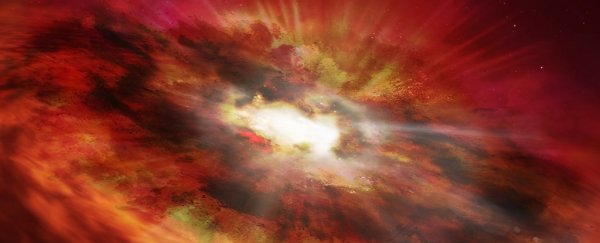A first-of-its-kind 'missing link' object detected in the early Universe may solve the mystery of the oldest supermassive black holes in existence, scientists say.
The discovery of GNz7q, a black hole dating back to just 750 million years after the Big Bang, aligns with theoretical predictions of what an 'ancestor' to supermassive black holes might look like – and while it's something we've never seen before, there could be many more like it.
"It's unlikely that discovering GNz7q … was just 'dumb luck'," says astronomer Gabriel Brammer from the University of Copenhagen in Denmark.
"The prevalence of such sources may in fact be significantly higher than previously thought."
 (NASA et al., full caption and credit below)
(NASA et al., full caption and credit below)
Above: GNz7q, the red dot in the center of the inset, in the Hubble GOODS-North field. (NASA, ESA, Garth Illingworth [UC Santa Cruz], Pascal Oesch [UC Santa Cruz, Yale], Rychard Bouwens [LEI], I. Labbe [LEI], Cosmic Dawn Center/Niels Bohr Institute/University of Copenhagen, Denmark)
The period GNz7q dates from is known as the Cosmic Dawn – the epoch spanning from around 50 million years after the Big Bang to around 1 billion years, when the earliest celestial objects were forming, including baby stars and fledgling galaxies.
At some point in these nascent phases of Universe evolution, supermassive black holes also turned up. But when and how remain open questions in astrophysics.
Last year, scientists announced the discovery of J0313–1806, the most distant quasar on record at over 13 billion light-years from Earth, signifying the oldest supermassive black hole ever found.
But where does something like J0313–1806 come from? Or rather, what kind of objects were the evolutionary precursors to supermassive black holes in the early stretches of the Universe?
Theoretically speaking, scientists have some ideas.
"Simulations indicate an evolutionary sequence of dust-reddened quasars emerging from heavily dust-obscured starbursts that then transition to unobscured luminous quasars by expelling gas and dust," researchers explain in a new study, led by first author and astronomer Seiji Fujimoto, also from the University of Copenhagen.
"Although the last phase has been identified out to a redshift of 7.6 [referring to J0313–1806], a transitioning quasar has not been found."
Until now, that is. Fujimoto, Brammer, and colleagues identified GNz7q in an analysis of archival observation data captured by the Hubble Space Telescope. The object looks to be the elusive ancestor scientists have been trying to track down.
Surprisingly, this 'missing link' black hole was found in a comprehensively studied region of the night sky – as part of the Great Observatories Origins Deep Survey (GOODS) – but only now has a spectral analysis identified what GNz7q's luminosity likely represents.
"Our analysis suggests that GNz7q is the first example of a rapidly growing black hole in the dusty core of a starburst galaxy at an epoch close to the earliest supermassive black hole known in the Universe," Fujimoto says.
"The object's properties across the electromagnetic spectrum are in excellent agreement with predictions from theoretical simulations."
According to the researchers, the host galaxy of GNz7q is incredibly active, forming around 1,600 solar masses of stars per year – or at least it was around 13 billion years ago, when this ancient light was emitted.
The signature of GNz7q's light emission fits the transitional black hole profile due to its brightness in ultraviolet wavelengths (representing emission from the outer part of the black hole's accretion disk) coinciding with an absence of X-ray emission (which would be generated at the core of the disk, but shrouded by the ongoing dusty conditions of the early starburst galaxy from which GNz7q evolved).
As the researchers explain, those characteristics are a perfect match for a black hole destined for supermassive things.
"Its properties are in excellent agreement with the transition phase of the evolutionary paradigm of supermassive black holes," the team explains in their paper. "A low-luminosity, dust-obscured quasar emerging in a vigorously star-bursting host."
In other words, this is what we predicted a supermassive black hole precursor would look like about 13 billion years ago, once its light finally reached us, having traveled some 13 billion light-years to make the trip.
Due to the phenomenon of the Universe expanding, GNz7q – in whatever ultimate, supermassive form it now takes – would be about twice as far away from us today, at a distance of around 25 billion light-years.
One has to wonder, how bright does it glow now?
The findings are reported in Nature.
